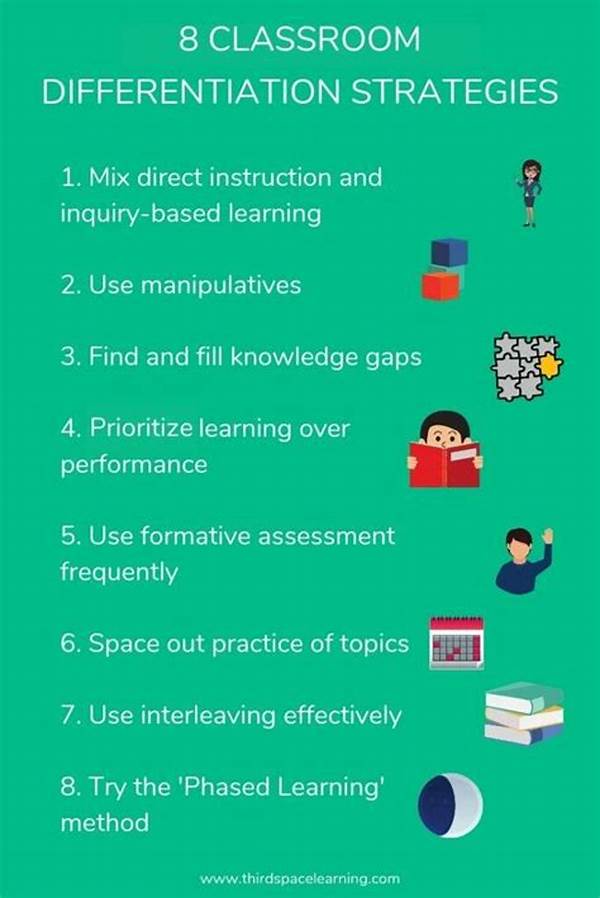In the realm of educational pedagogy, differentiated learning in math classrooms offers an innovative approach to addressing the diverse learning needs of students. This educational strategy aims to cater to the individual learning preferences, abilities, and interests of each student, thus enabling them to reach their full academic potential. By implementing differentiated instruction, educators can facilitate a more inclusive and effective learning environment, which is critical in nurturing mathematical proficiency and fostering a positive attitude towards the subject.
Read Now : Benefits Of Cultural Diversity In Education
The Importance of Differentiated Learning in Math Classrooms
Differentiated learning in math classrooms is essential for several reasons. Firstly, it acknowledges the varied learning paces and styles among students, ensuring that each learner receives the support and challenges they need. This approach prevents students from feeling left behind or unchallenged, thereby promoting an equitable educational experience. Secondly, differentiated learning fosters a growth mindset, encouraging students to view challenges as opportunities for development rather than insurmountable obstacles. Lastly, by tailoring instruction to meet individual needs, teachers can enhance student engagement and motivation, leading to improved academic outcomes. In summary, differentiated learning in math classrooms is a vital component of contemporary education, addressing the unique capabilities and potential of each student.
Strategies for Implementing Differentiated Learning in Math Classrooms
1. Assessment of Individual Needs: Prior to implementing differentiated learning in math classrooms, educators must assess the individual needs of their students. This can be achieved through various assessments and observations, providing insight into the strengths and areas for improvement for each student.
2. Flexible Grouping: Another strategy involves flexible grouping, where students are grouped based on their current understanding of a topic. This allows for targeted instruction tailored to the specific learning requirements of each group.
3. Varied Instructional Methods: Employing a variety of instructional methods, such as visual aids, hands-on activities, and technology, ensures that different learning styles are accommodated and maximizes student engagement.
4. Ongoing Feedback: Providing ongoing feedback is crucial in differentiated learning in math classrooms. Feedback should be constructive and aimed at guiding students’ learning processes, thereby facilitating continuous improvement.
5. Adapting Curriculum Content: Adaptation of curriculum content to suit diverse learning levels helps in maintaining an inclusive classroom environment, ensuring that all students can access and engage with the material effectively.
Challenges in Implementing Differentiated Learning in Math Classrooms
While the benefits of differentiated learning in math classrooms are considerable, educators may face several challenges. One of the primary challenges is the increased preparation time required for planning individual or small group lessons that cater to diverse learning needs. Additionally, managing a classroom where multiple activities are occurring simultaneously demands sophisticated organizational skills. Teachers may also encounter difficulties in assessing student progress and maintaining balanced attention among students of varying abilities. Despite these challenges, with adequate resources and support, differentiated learning in math classrooms can be a rewarding approach that significantly benefits both students and educators.
Read Now : Creative Ways To Display Portfolios
Differentiated Learning Techniques in Math Classrooms
Educators can employ various techniques to implement differentiated learning in math classrooms effectively. These methods can include differentiated lesson plans, peer teaching, and the use of technology to create interactive learning experiences. Differentiated lesson plans are tailored to suit the diverse capability levels of students, focusing on achieving personalized learning goals. Peer teaching encourages collaboration and knowledge sharing among students, fostering an inclusive learning atmosphere. Technology, such as learning apps and online platforms, offers interactive content that caters to various learning preferences and pacing. By integrating these techniques, teachers can ensure that mathematics instruction is accessible and engaging, promoting student success.
Creating an Inclusive Classroom Environment
Establishing an inclusive classroom environment is pivotal in implementing differentiated learning in math classrooms. Teachers can create a supportive atmosphere by acknowledging and celebrating diversity in the classroom. This involves being sensitive to cultural differences, learning disabilities, and varying socioeconomic backgrounds, ensuring that every student feels valued and included. Encouraging open communication and collaboration among students helps in building a sense of community, supporting social learning. Furthermore, ongoing professional development for teachers is crucial, as it equips them with the necessary skills and knowledge to effectively implement differentiated strategies. Such efforts contribute to a nurturing educational environment where all students can thrive.
Evaluating the Effectiveness of Differentiated Learning
In evaluating the effectiveness of differentiated learning in math classrooms, educators must adopt a comprehensive approach. This involves continuous monitoring and assessment of student performance, using both formative and summative evaluations. Collecting feedback from students provides valuable insights into their learning experiences, enabling teachers to refine instructional strategies. Additionally, collaboration with colleagues and educational experts can offer fresh perspectives and innovative ideas for enhancing differentiated instruction. Ultimately, the goal is to ensure that differentiated learning in math classrooms leads to measurable improvements in student engagement, understanding, and academic achievement.
Conclusion
In summary, differentiated learning in math classrooms represents a transformative approach to education, finely tuning instruction to cater to the diverse needs of students. This methodology not only enhances academic outcomes but also fosters an inclusive and engaging learning environment where each student can excel. Despite the challenges associated with its implementation, the benefits of differentiated learning in math classrooms are significant, promoting equity and excellence in education. As educators continue to embrace and refine this approach, they pave the way for students to develop strong mathematical foundations and lifelong learning skills.
